B.D.E
Hazard to Self
 
Posts: 97
Registered: 5-8-2019
Member Is Offline
Mood: Oscillating
|
|
Anthranilic acid preparation(questions)
hey there, I've read some thread about it. I also watched chemplayer video about the syntheses. I still have some questions.
most of the preparations I've read goes something like that:
1. 1eq of phtalamide is added to a concentrated solution containing 2eq of NaOH(aq)(T=0-10C).
2. after everything dissolve, 1eq of bleach is slowly added, and the mixture is heated to about 70-80C for 20-40min. The mixutre
allowed to cooled back to room temperature.
3. conc.HCl is added dropwise until reaching a PH of about 7.
4. glacial acetic acid is added and the product participate from solution.
my questions:
*how much acetic acid is needed? and why do we use it in the first place?
*I'm planing on using bromine instead of bleach, how much should I use? how much water should I use?
*I need the anthranilic acid for synthesis. any advice/tweaks for extra pure product?
reagents I have(and might be relevant):
phthalic anhydride
urea
NH3(aq)(25%)
KOH & NaOH
household bleach(3% NaOCl)
bromine
BCDMH
H2SO4(96%) & HCl(32%) & acetic acid(glacial)
[NH2OH*HCl] & [N2H4*2HCl]
EtOH & MeOH & BuOH & diethyl ether & DCM
[Edited on 6-5-2020 by B.D.E]
|
|
|
B.D.E
Hazard to Self
 
Posts: 97
Registered: 5-8-2019
Member Is Offline
Mood: Oscillating
|
|
P.S. I already tried the reaction using 3% household bleach(presumably without any additives), and it failed. the mixture became black upon heating,
the final product wad highly contaminated(tar like), and the recovery was slim(10% max).
This is why I came for your help :S
|
|
|
mackolol
Hazard to Others
  
Posts: 458
Registered: 26-10-2017
Member Is Offline
Mood: Funky
|
|
Product becomes black usually when you don't cook long enough your phthalimide. Black tar is the product of partially decarboxylated phthalic acid. I
have f*cked up few syntheses just because I forgot that phthalic anhydride - urea mixture must "froth up" increasing its volume drastically while
effervescence, and not just liquify.
There is second option for it being black, it happens when you add too much hypochlorite and that's why you must be really precise when measuring out
hypochlorite - phthalimide ratio.
You must be really precise either with neutralisation, otherwise your yield will suffer badly.
usually, a little acetic acid is needed after neutralisation. I usually added around 20ml 80% acetic for around half a liter reaction mixture, but be
carefull with bubbling, add the AA very slowly with good stirring.
I hate CO2 because almost always I tend to spill the shit out of it.
And as for bromine... I don't know why bromine if concentrated bleach is cheap as dirt, but here you have the video on youtube about doing it with
bromine: https://www.youtube.com/watch?v=-_Mt7NaSBR4
In case you don't know how to make phthalimide: https://www.youtube.com/watch?v=iHwdpznQNnk
Seriously it's not that hard to type "synthesis of anthranillic acid" in your browser, or just to count what ratio do you need...
[Edited on 6-5-2020 by mackolol]
|
|
|
mackolol
Hazard to Others
  
Posts: 458
Registered: 26-10-2017
Member Is Offline
Mood: Funky
|
|
Quote: Originally posted by B.D.E  |
*how much acetic acid is needed? and why do we use it in the first place?
[Edited on 6-5-2020 by B.D.E] |
We don't use acetic acid in first place, because it is way cheaper to do it with hydrochloric acid and you dont dilute the mixture so much.
However hydrochloric acid forms water - soluble salt with anthranillic acid's amine group. Anthranillic acid is amphoteric, which means, it forms
salts with either strong acids and bases. It doesn't though, with such weak acid as acetic, thats why after neutralisation, you make it acidic with
acetic acid.
|
|
|
Tsjerk
International Hazard
    
Posts: 3022
Registered: 20-4-2005
Location: Netherlands
Member Is Offline
Mood: Mood
|
|
Quote: Originally posted by mackolol  |
Seriously it's not that hard to type "synthesis of anthranillic acid" in your browser, or just to count what ratio do you need...
[Edited on 6-5-2020 by mackolol] |
Apparently it was for you... or at least to preform the reactions properly. I did have some problems finding a proper procedure and had to go through
many to come up with a single working one. So here is what I found:
I just made some anthranilic acid and found my procedure to be quite straight forward and got a 56% yield, 66% if you count the copper anthranilate I
recovered after adding copper sulfate to the filtrate.
If you want to get rid of the phthalic acid in your phthalimide you can boil the imide in water for a couple of minutes and filter hot. Wash with a
bit of warm water. Phthalic anhydride will hydrolyze to the acid, which is soluble in hot water. Phthalimide is hardly soluble. Actually this is the
only work-up I did for my phthalimide made from phthalic anhydride and urea, just take the whole reaction mixture and boil in water, filter hot and
wash with warm water to get rid of the urea and phthalic anhydride/phthalic acid. 81% yield.
I used 12.5% sodium hypochlorite reagent grade to do the Hofmann rearrangement, how sure are you there are no additives in your bleach? I would use
the bromine if I were you. A solution of hypobromite is made by adding 1 eq. bromine to 2 eq NaOH in solution while keeping everything cold. I think
aiming for a 10-20% solution should be fine for this rearrangement.
The reason you use acetic acid is that strong acids like hydrochloric acid or sulfuric acid (you can use it to go to pH 7) will dissolve your
anthranilic acid. Acetic acid is used to get the solution to around pH 3.
I don't know what Chemplayer did (shouldn't links to references be obligatory...especially when they are not literature?) but I used 2.2 eq. of NaOH
as a 20% solution in water to dissolve the phthalimide. This solution should be colorless if your reagents are pure. Warm if necessary to dissolve
everything, cool down on an ice bath and slowly add the hypochlorite or hypobromite solution (no extra NaOH was added) while cooling. The solution
turns a bit yellow. Stir for 20 minutes while cooling and heat to 80 degrees for one or two minutes, everything should still be yellow, or a bit
orange at most.
(you can make isatoic anhydride if you omit the 80 degrees step, keep everything extra cold and make sure to use a small excess of phthalimide
compared to the hypochlorite/bromite and only use one eq. of NaOH)
Cool again and add HCl/H2SO4 until neutral, add around 10 ml glacial acetic acid per 10 grams of phthalimide used. Filter of the product and wash with
cold water. The product should be creme colored or a bit yellow. I have seen things on Youtube and Bitchute ranging from dark brown to gray and even
to black, if this happens you did something wrong.
You can recover a bit of anthranilic acid from the filtrate with Cu(II), but freeing the acid from the copper is not fun, I just keep it for display,
it has a real nice green color.
-----------------
Phthalic anhydride: I just put phthalic acid in a beaker with an equally sized beaker on top to prevent sublimation and put that on a hot plate until
the acid melts and stops boiling. After cooling a bit but before solidification of the anhydride the product was poured on aluminium foil. This
preparation should be close to quantitative.
Phthalimide: 10 grams of anhydride with 2 grams of urea are pulverized and put in a large beaker/flask with something to cover and heated on a
hotplate. High temperature doesn't seem to be a problem. Within minutes things melt, and soon everything froths. After cooling everything is
pulverized and water is added and the water is boiled for a couple of minutes, the reaction is filtered hot and washed with warm water to get rid of
the urea and phthalic acid.
[Edited on 6-5-2020 by Tsjerk]
[Edited on 6-5-2020 by Tsjerk]
|
|
|
chemplayer...
Hazard to Others
  
Posts: 191
Registered: 25-4-2016
Location: Away from the secret island
Member Is Offline
Mood: No Mood
|
|
This one did actually take a few goes to get any sort of half decent yield, and 5-6 attempts before the protocol we put into the video was good
enough. We also tried with liquid bromine to start with and it resulted in crazy exotherms on reacting, and very poor yields (10%). Additionally
bromine is not exactly pleasant to handle.
One tip is use the cheapest but strongest bleach you can get. Anything with additives and thickening agents and colour / aroma compounds in it will
result in a fail. You want pale lemon yellow watery liquid non-frothy sodium hypochlorite solution of at last 5%. If your reaction turns black then
you've probably got additives / contaminants in there.
The product can be recrystallised but we never managed to get a 'creamy' white coloured product from this as the heat required does seem to somehow
have an impact on the product. The power you get if washed well from the reaction is fine for subsequent experiments, and ironically tends to be paler
coloured than the recrystallisation product.
|
|
|
Texium
Administrator
       
Posts: 4508
Registered: 11-1-2014
Location: Salt Lake City
Member Is Offline
Mood: PhD candidate!
|
|
This is my write-up of the procedure from three years ago, following chemplayer's video:
https://texium.wordpress.com/2017/03/22/preparation-of-anthr...
I used 10% sodium hypochlorite solution that is sold for swimming pools. It doesn't contain any additives or surfactants, and is actually cheaper than
less concentrated household bleach. I got a 46% yield.
I can also confirm that the best way to have a reasonably pure product is to avoid messing with it. I also tried recrystallizing some of my product,
and had the same experience as chemplayer. Although I got bigger crystals than what I started with, it actually became darker and less pure. The tan
product works just fine, and the impurities generally become easier to resolve downstream.
[Edited on 5-6-2020 by Texium (zts16)]
|
|
|
mackolol
Hazard to Others
  
Posts: 458
Registered: 26-10-2017
Member Is Offline
Mood: Funky
|
|
I noticed, that if NaOH solution is too cold, phthalimide doesn't want to dissolve in it. Although it can't be to warm either not to hydrolise it.
|
|
|
G-Coupled
Hazard to Others
  
Posts: 287
Registered: 9-3-2017
Member Is Offline
Mood: Slightly triturated
|
|
What´s happening to the product upon recrystallisation that makes it darker, I wonder?
|
|
|
B.D.E
Hazard to Self
 
Posts: 97
Registered: 5-8-2019
Member Is Offline
Mood: Oscillating
|
|
wow. I'm overwhelmed by the amount of people willing to spare from their time just to help a stranger. this is truly an awesome community!
@mackolol
thanks for the help! I heated the {urea&pthalic anhydride} mixture until it puffed up, washed it with cold water and recrystallize it from hot
methanol. even so, some anhydride sublimed(thus didn't react) and most likely contaminated my final product. as for the NaOCl - the label on gallon
says it's "3% NaOCl mixed with distilled water". assuming this is true - I used exactly 1eq of NaOCl(based on pthalamide). I still have uncertainties
about the purity and concentration of my hypochlorite. this is why I prefer using bromine instead(it's instantly available for me, chemically pure,
and easy to measure). I did searched for "synthesis of anthranillic acid", but I couldn't found any reliable sources that were also detailed(using
bromine). for instance, the video you linked didn't mentioned what quantities he used. also, I already opened a thread, why not asking about it too?

@Tsjerk
wow. this is so very helpful. thank you so much!! I would be sure to follow your advice and detailed instructions.
also: chemplayer video about the synthesis(fixed)
Much much thanks to everyone else. it's a bit pointless replying each of you individually(as I have nothing to add), but I really appreciate all of
the help!
I'll be sure to update on my next attempt.
[Edited on 7-5-2020 by B.D.E]
|
|
|
chemplayer...
Hazard to Others
  
Posts: 191
Registered: 25-4-2016
Location: Away from the secret island
Member Is Offline
Mood: No Mood
|
|
Here's the video link (there was a 'dot' in the one above): https://www.bitchute.com/video/lt07v5I2lSEp/
|
|
|
njl
National Hazard
   
Posts: 609
Registered: 26-11-2019
Location: under the sycamore tree
Member Is Offline
Mood: ambivalent
|
|
Hey @B.D.E: I don't use retail bleach solutions because they tend to degrade over short periods of time. Also, I have never seen a prep that just uses
bromine, always bromine + hypochlorite to generate hypobromite in situ. That might be something to keep in mind, although bromine alone may be a good
enough oxidizer for you.
|
|
|
S.C. Wack
bibliomaster
    
Posts: 2419
Registered: 7-5-2004
Location: Cornworld, Central USA
Member Is Offline
Mood: Enhanced
|
|
Quote: Originally posted by mackolol  | | I noticed, that if NaOH solution is too cold, phthalimide doesn't want to dissolve in it. Although it can't be to warm either not to hydrolise it.
|
It's not expected to dissolve while cold, even if finely ground.
Phthalam-ic aka -idic acid will dissolve and is easier to make, from the anhydride and conc. ammonia. The yields with hypohalite are not higher.
|
|
|
Pumukli
National Hazard
   
Posts: 686
Registered: 2-3-2014
Location: EU
Member Is Offline
Mood: No Mood
|
|
Depending on your aim, preparing isatoic anhydride might actually be a more desirable goal.
Edit: typo removed
[Edited on 8-5-2020 by Pumukli]
|
|
|
B.D.E
Hazard to Self
 
Posts: 97
Registered: 5-8-2019
Member Is Offline
Mood: Oscillating
|
|
Okay, so I ran the synthesis on a small scale(4.19gr of phthalamide), and it worked great :D
I mostly followed Tsjerk instructions, maybe with one or two small changes.
here are my notes and observations:
a solution of ~10% NaOBr was made by slowly dripping 4.61gr of liquid bromine into a cool aqueous solution of NaOH(2.63gr/24.35mL). the addition took
place in an ice bath(T=2-6°C) with strong stirring. during the addition the solution took a bright yellow color, which is expected(NaOBr is a
yellow-orange solid). the solution kept in an ice bath until being used.
the NaOBr solution(w(NaOBr)/w(H2O)~10%):
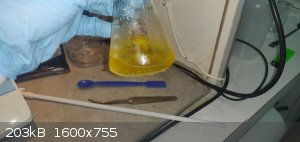
a second aqueous solution of NaOH(2.62gr/11mL) was made and cooled down to about 7°C. to said solution, 4.19gr of phthalamide was then added in small
portions. (in an ice bath, T=5-9°C)(with s.stirring).
after ~10min in which the phthalamide didn't fully dissolved(not even close), I decided to just start adding the cold(~4°C) NaOBr solution. (in an ice bath)(with s.stirring). the entire addition took less than a minute, in which the temperature never rose
above 8°C.
the solution kept stirring(while cold) for ~30min, in which the yellow color of the solution gradually fainted(but not completely, meaning it only
partially reacted).
the solution was then heated to 85°C. (in an oil bath)(with s.stirring). afterwards it was immediately removed
from the oil bath and allowed to cool in the air(while still stirring).
during the heating, the solution took an orange color:
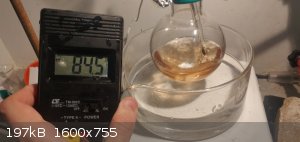
after cooled back to ~R.T, the solution was placed in an ice bath for 5-10min. I then put aside ~10mL of the solution, and began adding concentrated
HCl(aq), dropwise, until reaching a pH of ~7. after reaching said pH I poured back the 10mL from earlier.
5.5gr of glacial acetic acid was then added to the solution by a pipette. it foamed like crazy but luckily didn't overflow( ). ).
I poured the mixture into a buchner funnel, washed the flask twice with a cold solution of acetic acid(aq)(~2gr/20mL) to remove any
leftover solids, vacuum filtered everything, and washed it all with 3 portions of 5mL ice cold dH2O.
I transferred everything to a watchglass, and oven dried it for about an hour(T=100°C).
some pictures:
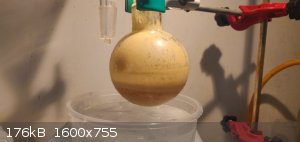 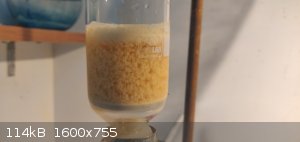 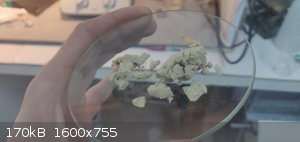
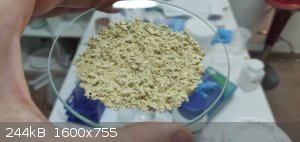 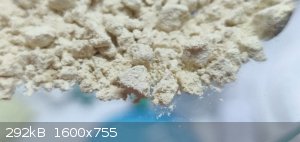
final yield(dry) was 2.06gr which correspond to 66.5% yield which is awesome(especially due to the high relative portion of mechanical losses).
I ran a melting test and here's the results(the video is sped up for convenience):
Attachment: MT.mp4 (6MB)
This file has been downloaded 348 times
---
I actually do have more to say and ask on the matter: alternative routes of synthesis, crystallization from ether(which I actually tried and got some
interesting results), purity and suitability for a reaction I'm interested in.
but this post is quite long as it is, so I'll probably save those for later.
feel free to ask me about the synthesis or the final product(if you have any).
[Edited on 9-5-2020 by B.D.E]
|
|
|
Tsjerk
International Hazard
    
Posts: 3022
Registered: 20-4-2005
Location: Netherlands
Member Is Offline
Mood: Mood
|
|
Very nice, I already thought hypobromite should work comparable to hypochlorite, nice to see it confirmed.
Nicely colored product you have, that is how mine looks like, this should be fine for any downstream purpose.
In retrospective I think it is indeed better to not warm the solution of phthalimide, as mackolol mentioned above it probably hydrolyses quite
extensively. I found some literature somewhere (can't find it anymore) where they indeed claim 10-20% hydrolysis in a short time period at 20-30
degrees Celsius. I guess as the reaction proceeds all phthalimide will go into solution and react anyway.
Did you save the filtrate? It would be interesting to see how much anthranilate is in there, you can easily precipitate it with an excess of Cu(II).
Your method of precipitation is a bit different from mine, as you added the 10 ml of reaction mixture after neutralizing to pH 7.
[Edited on 9-5-2020 by Tsjerk]
|
|
|
B.D.E
Hazard to Self
 
Posts: 97
Registered: 5-8-2019
Member Is Offline
Mood: Oscillating
|
|
Quote: Originally posted by Tsjerk  | Very nice, I already thought hypobromite should work comparable to hypochlorite, nice to see it confirmed.
Nicely colored product you have, that is how mine looks like, this should be fine for any downstream purpose.
In retrospective I think it is indeed better to not warm the solution of phthalimide, as mackolol mentioned above it probably hydrolyses quite
extensively. I found some literature somewhere (can't find it anymore) where they indeed claim 10-20% hydrolysis in a short time period at 20-30
degrees Celsius. I guess as the reaction proceeds all phthalimide will go into solution and react anyway.
[Edited on 9-5-2020 by Tsjerk] |
thanks :) you were definitely right about using hypobromite. I was a bit concerned about decomposition to NaO3Br and NaBr(apparently NaOBr
is much less stable than NaOCl[based only on wikipedia]), but I figured that as long as I keep everything nice and cool until use - I'm probably good. not sure whether or not it was
necessary(but better safe than sorry).
| Quote: |
Did you save the filtrate? It would be interesting to see how much anthranilate is in there, you can easily precipitate it with an excess of Cu(II).
Your method of precipitation is a bit different from mine, as you added the 10 ml of reaction mixture after neutralizing to pH 7.
|
I did saved the filtrate, but I already tried extracting leftover anth. by mixing it with diethyl ether(solubility data). unfortunately the ether slowly melted the plastic plate I poured it onto... I do plan on precipitating the copper salt from
it(as I'm a bit short on ether), but it's definitely damaged the certainty of any quantitative analysis based on it.
and the 10ml idea is from chemplayer's video :)
[Edited on 9-5-2020 by B.D.E]
|
|
|
Tsjerk
International Hazard
    
Posts: 3022
Registered: 20-4-2005
Location: Netherlands
Member Is Offline
Mood: Mood
|
|
I have to admit I heard about the 10 ml trick via via.. I did watch PoorMans Chemist's video who refers to Chem player's video. Yes, priorities...
The ether extraction shouldn't be a problem for the copper precipitation. As long as the extracts from the ether extraction are taken in consideration
the copper precipitate should be quantitative. As long as the pH doesn't go above 7, which would precipitate the copper as the hydroxide.
|
|
|
S.C. Wack
bibliomaster
    
Posts: 2419
Registered: 7-5-2004
Location: Cornworld, Central USA
Member Is Offline
Mood: Enhanced
|
|
BTW Vogel uses hypobromite (also Henle, via Weygand), with disagreement with the point 1 at the top which I haven't seen in any literature (although
some come close).
|
|
|
B.D.E
Hazard to Self
 
Posts: 97
Registered: 5-8-2019
Member Is Offline
Mood: Oscillating
|
|
but the extraction have
failed(.I don't know how much was extracted).
Quote: Originally posted by S.C. Wack  | | BTW Vogel uses hypobromite (also Henle, via Weygand), with disagreement with the point 1 at the top which I haven't seen in any literature (although
some come close). |
what is "point 1"(I have more than one guess).
|
|
|
S.C. Wack
bibliomaster
    
Posts: 2419
Registered: 7-5-2004
Location: Cornworld, Central USA
Member Is Offline
Mood: Enhanced
|
|
The first of four. BTW+, the fifth ed. of Vogel seems to address mackolol's point, inserting a line of text not present in the third ed., but leaving
the rest mostly unchanged.
|
|
|
B.D.E
Hazard to Self
 
Posts: 97
Registered: 5-8-2019
Member Is Offline
Mood: Oscillating
|
|
Quote: Originally posted by S.C. Wack  |
The first of four. BTW+, the fifth ed. of Vogel seems to address mackolol's point, inserting a line of text not present in the third ed., but leaving
the rest mostly unchanged. |
I guess you're right. one could just add the phtalamide into the
hypobromite/chlorite solution.
|
|
|